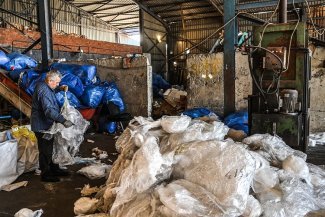An estimated 50,000 people are thought to be working in slavery-like conditions in India’s brick kilns.
When Brijesh Yadav borrowed US$300 from a contractor for his sister’s wedding, it was the beginning of a long nightmare. To pay it back, he and his family travelled some 1,000 kilometres from the impoverished northern Indian state of Uttar Pradesh to work in a brick kiln in the wealthy western state of Gujarat.
“They would beat me day and night,” Brijesh says of the kiln’s managers. “I have worked as a labourer [on farms] for many years but that was the first time I was beaten.”
His wife, three young children under the age of 10 and his ageing father all worked at the kiln, yet Brijesh was the only one officially employed – and paid.
Brijesh is one of approximately 25 million people working in over 100,000 brick kilns across India, according to figures quoted by Anti-Slavery International. An estimated 50,000 of those people are thought to be working in slavery-like conditions, says Sudhir Katiyar, project director of the Prayas Centre for Labour Research and Action, an NGO based in the state of Rajasthan in north-west India.
The organisation, which focuses on promoting worker welfare across several key informal worker groups in India, says the violence in brick kilns ranges from verbal abuse to beatings and rape.
Over the past decade India has seen a real estate boom. As a result, red bricks for construction are in high demand. A 2013 study by Global Construction Perspectives, a construction and infrastructure-focused think tank, and the Oxford Economics advisory firm, predicted that by 2030, India – which is already one of the world’s biggest construction markets – will be worth US$1 trillion a year.
However, behind the glossy façade of economic progress lies an industry largely built on the back of cheap labour. As a result, Indian brick kilns have earned a notorious reputation as sites of extreme exploitation.
Some builders in the country have adopted new construction techniques such pre-fabrication, which uses alternative materials like steel and concrete. But Indians still prefer fired red bricks and for most of the country, the ‘construction boom’ signifies moving from makeshift homes to permanent, respectable brick and mortar houses.
“Red bricks fired in kilns still constitute almost 80 per cent of the market for bricks in India, and because of their long history, they continue to remain popular,” says Sameer Maithel, director of the Greentech Knowledge Solutions advisory firm.
Kiln mafia
Some kilns function like debtors’ prisons, or worse, with at least tacit official consent, NGOs say.
“Often, brick kilns hire ‘muscle men’ to prevent labourers from leaving. It is almost like a mafia operation,” says Ashok Mathews Philip, director of the South India Cell for Human Rights Education and Monitoring (SICHREM).
“They take away any jewellery the women have. If the husband has to leave the kiln for a trip back home, they will hold the wife back as surety. They will also have the muscle men staring at the labourers, intimidating them in different way,” Philip tells Equal Times.
Philip himself was beaten up at a brick kiln while on a rescue operation, even though he was accompanied by labour officials and police officers. “One gets the sense that kilns have these officials on a payroll. When we receive a complaint from workers through helplines or unions, the authorities refuse to act promptly,” he says.
NGO workers involved in rescuing bonded labourers at brick kilns say that traffickers often recruit kiln workers from poverty-stricken small towns in India.
As with Brijesh, the modus operandi involves offering vulnerable families an advance to meet some impending expense, after which the family that accepted help from the middleman has to work in brick kilns to pay off the advance. Families that wish to leave the kiln before the advance is recovered, pay high levels of interest on their debt.
“In many brick kilns, the creditor-debtor relationship determines the working atmosphere and makes kiln workers vulnerable to abuse,” says Naveen Gautam, a human rights lawyer who has also been involved in raid and rescue operations in brick kilns in the north-western state of Punjab.
Gautam says the conditions in the kilns are absolutely horrific. “It is like hell,” he tells Equal Times. “Often, there are about 100 people living in small rooms built out of the bricks they made themselves. Open defecation is common, with a large number of workers – both male and female – sharing a single hole in the ground for the purpose, due to which illnesses are also common.”
Like Brijesh’s wife, women working in brick kilns are ‘invisible’, because their labour is not taken into account and payments are made only against the husband’s production. Despite the fact that human rights NGOs say that women make up half of the workforce, according to official records from both the government and the brick industry there are no women working in India’s brick kilns.
Escape from the abuse
At brick kilns, wages are linked to production. Most wages only meet food expenses because workers are technically paying off the advance, and how much the workers get to eat depends on the number of bricks they make. After working at the kiln for eight months, the Yadavs had paid off the advance that they had borrowed. However, the kiln owners refused to let them go.
When the Yadavs protested, the kiln held the family as prisoners – they wouldn’t let them go, but they wouldn’t let them work either, leaving them without any money to buy food. This, the Yadavs claim, was not just to punish them for asking to be relieved but also to intimidate the other workers.
Eventually, Brijesh and his family were rescued with the help of the Int Bhatta Majdur Union (Brick Kiln Workers Union), based in the city of Ahmedabad in Gujarat. Today, the family is back in their home state and work as farm labourers. It’s been three years since they left the brick kiln but the harassment continues.
“Even now, they [the local traffickers] knock on our doors and demand more money,” says Brijesh.
Others who have clashed with the brick kiln mafia are forced to pay a heavier price. In 2014, two men who escaped while being forcibly taken to work in kilns had their hands chopped off.
There is also some evidence to suggest that brick kiln workers – who are often desperately poor, illiterate and vulnerable – are abused in other inhumane ways.
Reports by the international NGO ActionAid, as well as local NGOs such as Katiyar’s Prayas Centre for Labour Research and Action, contain accusations of organ trade at brick kilns.
One woman, Bilasani, lost both her husband and her son two months after the family went to work at a brick kiln, the ActionAid report says. “Bilasani retrieved his [the husband’s] body outside the hospital, swollen and with two long and suspicious cuts in the region of the stomach.”
The report continues: “Distraught and troubled by allegations by passersby that her husband had fallen victim to trade in trafficked organs, and her son was gotten rid of for protesting, Bilasani, after many ordeals, returned home.”
Better future?
In recent years, and particularly after the Paris Climate Deal, India has received much flak for its consumption of coal. According to official estimates, the Indian brick industry consumes approximately 35 million tonnes of coal each year, and is a major source of greenhouse gas emissions. Will going green improve the plight of the workers in the Indian brick industry?
“Some improvements are observed in kilns that have adopted green technologies,” says Maithel of Greentech Knowledge Solutions. “However, the key to improved working conditions lies in adopting appropriate mechanisation across all operations, which is still rare.”
According to Maithel, working conditions at kilns improves when some aspects of brick-making – such as mixing clay, shaping bricks and digging or transporting soil – are mechanised.
Making the brick industry a year-round industry (presently it only functions during the seasons when farm labourers are free to work), along with appropriate mechanisation will help transform informal brick-making into an organised small-scale industry, Maithel says. That could contribute to a reduction of carbon emissions as well as in the improvement of working conditions. But the transformation will not be easy, warns Maithel, and will require the support of the government, developmental organisations as well as financial institutions.










